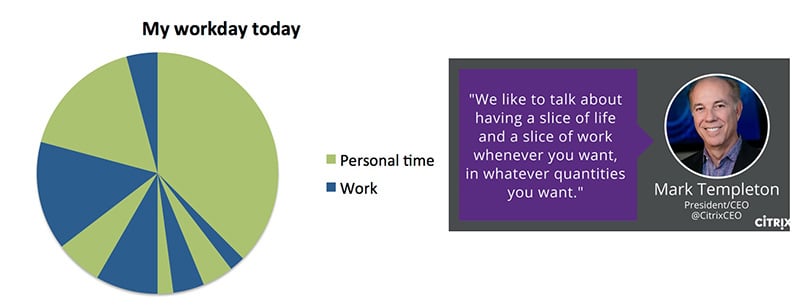Taking Another Look at Life Slicing
*This post originally appeared on the AppSense blog prior to the rebrand in January 2017, when AppSense, LANDESK, Shavlik, Wavelink, and HEAT Software merged under the new name Ivanti.
Does our preoccupation with efficiency create cyber-security risk?
At Citrix Synergy 2012, then-CEO Mark Templeton discussed an enormous change in our work-life paradigm driven by changes in corporate technology. Users were no longer tied to desktops running legacy applications from fixed terminals which sat within the corporate office. Instead, users could jump between their work and personal lives utilizing multiple platforms and devices, from multiple locations.
Templeton called it Life Slicing.
I enlarged on this topic at the 2012 AppSense Sales Kick Off. As technology users, we can easily fuse together our personal and work lives, jumping from various devices throughout the day, checking email in between dinner and/or watching episodes of Breaking Bad, EastEnders, Neighbours, or Baywatch – (dependent on your nationality or personal taste).
A typical evening of time slicing
After the Synergy conference, ZDNet ran an article on “Life Slicing” and posed the question, “Is this necessarily a good thing?” Article author Edwin Yapp reflected his concern that with the new paradigm that we would never “switch off” from work and speculated on how Life Slicing could affect our culture and lives.
Fast forward to today. Whilst you could argue that while many employees can to leave work at 5:30 pm and “switch off”, there are still a considerable number in the mobile workforce who Life Slice every single day. We jump from laptop to tablet, from Windows to Mac, from desktop to phone. We check emails on the train, we write documents in the air, we check Facebook in work, we read the news from our corporate PC. Hell, some people check their work email on holidays and others may, albeit reluctantly, admit to replying to their boss via email from the toilet (“It was an urgent email, right?”).
Our desire to stay connected, respond quicker, and “cross the next item of our to-do list” drives us to Life Slice every day. And technology is right in front of us, making it ridiculously easy. We can switch applications with a double tap and have multiple connections to the web open at any time. Even as I write this, my email is popping up in the bottom right hand corner of my screen, and I find myself tabbing between Word and Outlook, replying to emails when I should be finishing this blog.
But, right along with Life Slicing and multi-tasking joy, the number and variety of cyber threats is increasing at a phenomenal rate. The user and their device are always under attack, and the user is arguably referred to as the weakest link. Malware, phishing and ransomware attacks are more targeted than ever, and are being carried out for significant financial gain—not just for fun!
The ability to protect against this cyber-threat tsunami wave is really, really hard. No single solution can prevent every attack—security is all about a layered approach.
Whilst security technology and solutions can mitigate some of the risk,, I pose a question.
In a world where the user is Life Slicing more than ever before, where the user is the weakest link, and where technology is struggling to protect us, do we all need to slow down a bit and be more conscious and aware of what we are doing when living in cyber space?
Is one of the biggest risks the way we now work, always aiming for uber-efficiency? Should we take time to read our emails more than once and double check who they are from? Should we flag our emails to read later when we back at your PC rather than squinted at a teeny screen in a dimly-lit restaurant? Should we finish one task before we start another and be very careful as we jump across multiple applications to avoid jumping into cyber mayhem?
Should we spend less time Life Slicing?

